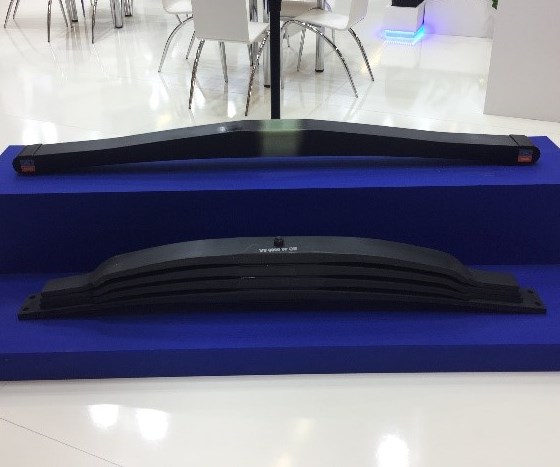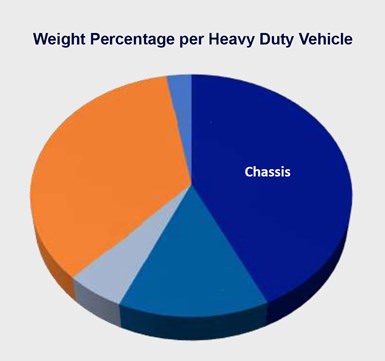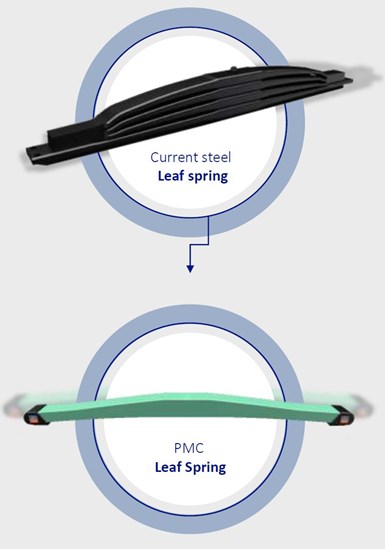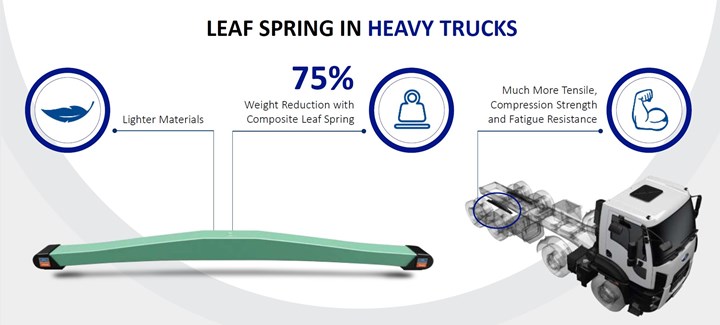Kordsa works with Ford Otosan to develop composite leaf springs for heavy trucks
Prepreg compression molding prototype achieves 75% weight savings while boosting performance.

Kordsa (Istanbul, Turkey) is a global supplier of tire and construction reinforcements and technology for composites that has recently expanded its aerospace capabilities through acquisition of multiple U.S.-based companies (see Jeff Sloan’s blog, “The Kordsa strategy”). The company is also expanding its offerings in automotive and heavy truck, evidenced by its presentation at the Turk Kompozit 2019 Composite Summit (Oct. 10-12, Istanbul) titled, “Kordsa’s Material Development for Composite Leaf Spring Production for Heavy Commercial Vehicles.” This presentation discussed technology developed jointly Kordsa and Ford Otosan, which lightens the heavy truck chassis systems for Ford Trucks and includes structural health monitoring systems for process optimization, part qualification and online health monitoring.

Kordsa explains that chassis components are a unique opportunity for composites because they comprise the largest single percentage of the vehicle weight, yet they are structural parts under repetitive dynamic loads.
The goal for Kordsa and Ford Otosan is to reduce CO2 emissions and enable increased fuel efficiency and payload by producing a composite leaf spring to reduce weight 75% versus steel. This would also reduce the vehicle’s unsprung weight mass for follow-on weight reduction in other systems and improved comfort via reduced noise, vibration and harshness (NVH) levels.

The targets for this heavy truck composite leaf spring are challenging. It must withstand an axle load of 13.4 tons and withstand a rigorous service environment, providing a long fatigue life of 1 million kilometers minimum. Accordingly, this thick composite part — up to 110 millimeters — must have a sufficiently high fiber volume and low void content as well as glass transition temperature (Tg) between 120-150°C. Production rate must align with that for heavy trucks — up to 10,000 parts/year — mandating a cure cycle less than 1 hour, while costs must be competitive.
Kordsa and Ford Otosan chose prepreg compression molding for its ability to deliver homogeneous resin distribution and optimized stiffness via improved fiber alignment with less distortion and reduced thickness variation, in a process offering high reliability and repeatability. Kordsa produced a variety of unidirectional carbon fiber and glass fiber/epoxy prepreg batches and performed full materials characterization on each, developing the materials data needed by Ford Otsan for input into computer-aided engineering (CAE) tools. It then worked to fully detail the load case for a prototype heavy truck leaf spring and used fiber bragg grating (FBG) sensors to verify loads and explore production parameters as well as fatigue properties.
The final prototype achieved 75% weight savings versus steel while increasing tensile strength, compression strength, and fatigue resistance. Kordsa will continue development with Ford Otosan and other transportation manufacturers, proving itself as a valuable ally in the campaign to reduce CO2 emissions globally by lightweighting cars, trucks, aircraft and ships through lighter weight composite structures versus heavier steel, aluminum and magnesium alternatives.

SOURCE | Kordsa and Ford Otosan
Related Content
-
Composites manufacturing for general aviation aircraft
General aviation, certified and experimental, has increasingly embraced composites over the decades, a path further driven by leveraged innovation in materials and processes and the evolving AAM market.
-
CompoTech uses integrated loop technology to create high-performance mountain bike
CompoTech features its CDuro Epona mountain bike fitted with custom suspension forks, manufactured using its AFL winding and integrated loop technologies.
-
Carbon fiber satellite arm reduces weight, simplifies assembly onto naval vessels
Satcom developer EM Solutions partnered with ACS Australia to replace an aluminum arm design with a 65% lighter, one-piece, corrosion-resistant carbon fiber/epoxy alternative.
















